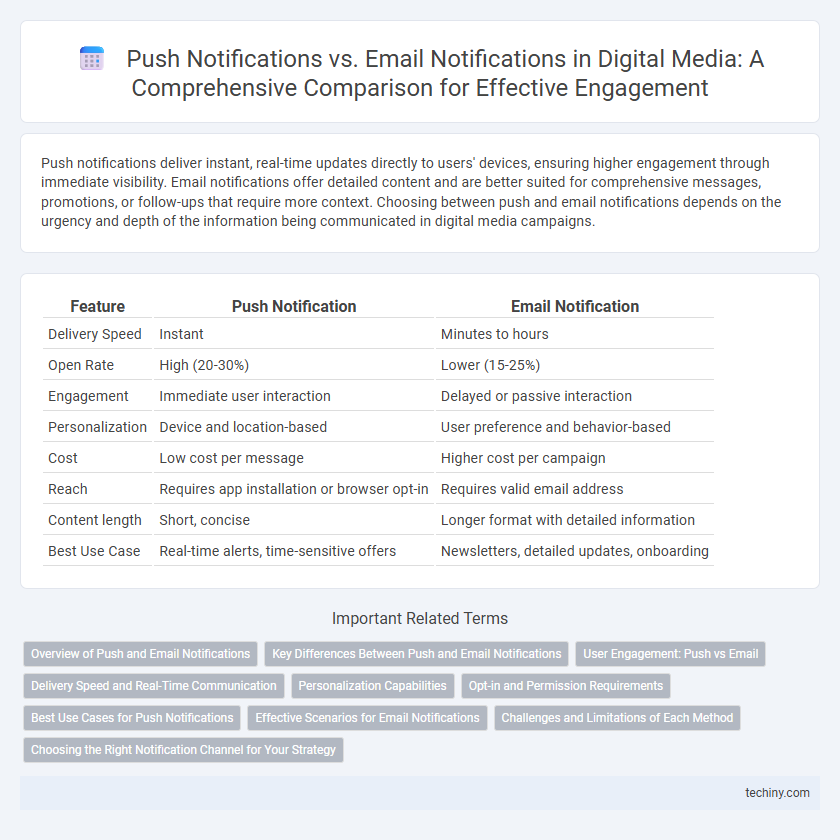Push notifications deliver instant, real-time updates directly to users' devices, ensuring higher engagement through immediate visibility. Email notifications offer detailed content and are better suited for comprehensive messages, promotions, or follow-ups that require more context. Choosing between push and email notifications depends on the urgency and depth of the information being communicated in digital media campaigns.
Table of Comparison
| Feature | Push Notification | Email Notification |
|---|---|---|
| Delivery Speed | Instant | Minutes to hours |
| Open Rate | High (20-30%) | Lower (15-25%) |
| Engagement | Immediate user interaction | Delayed or passive interaction |
| Personalization | Device and location-based | User preference and behavior-based |
| Cost | Low cost per message | Higher cost per campaign |
| Reach | Requires app installation or browser opt-in | Requires valid email address |
| Content length | Short, concise | Longer format with detailed information |
| Best Use Case | Real-time alerts, time-sensitive offers | Newsletters, detailed updates, onboarding |
Overview of Push and Email Notifications
Push notifications deliver real-time alerts directly to users' devices, enabling immediate engagement with personalized content, offers, or updates. Email notifications provide a more detailed communication channel, allowing for rich formatting and comprehensive messaging suited for newsletters, promotions, or transactional information. Both channels play crucial roles in digital media strategies by targeting user attention through timely and contextually relevant messages.
Key Differences Between Push and Email Notifications
Push notifications deliver real-time, immediate alerts directly to users' devices, ensuring higher visibility and quicker engagement compared to email notifications, which often rely on users checking their inbox. Email notifications offer greater content flexibility, supporting detailed messages, rich media, and longer formats, while push notifications are typically concise and designed for instant action. User opt-in rates and personalization options differ, with push notifications leveraging device-level permissions and geo-targeting, whereas email marketing depends on subscription preferences and segmentation strategies.
User Engagement: Push vs Email
Push notifications generate higher user engagement rates by delivering real-time, personalized alerts directly to mobile devices, resulting in immediate actions and increased app retention. Email notifications, while valuable for detailed content and broader communication, typically experience lower open rates and slower user responses compared to push messages. Optimizing push notifications with targeted timing and content can significantly enhance user interaction compared to traditional email campaigns.
Delivery Speed and Real-Time Communication
Push notifications deliver messages instantly to users' devices, ensuring immediate visibility and engagement in real-time communications. Email notifications, while effective for detailed content, often face delays due to server processing and user inbox checking, reducing their immediacy. For time-sensitive updates and rapid interaction, push notifications outperform email in delivery speed and real-time responsiveness.
Personalization Capabilities
Push notifications offer superior personalization capabilities by enabling real-time, location-based, and behavioral targeting that enhances user engagement. Email notifications allow for rich content customization through dynamic templates and detailed segmentation based on user preferences and past interactions. Both channels leverage data analytics, but push notifications provide immediacy and contextual relevance that drive higher conversion rates.
Opt-in and Permission Requirements
Push notifications require explicit opt-in from users, often through app settings or website prompts, ensuring immediate and direct communication channels. Email notifications demand prior consent typically obtained via subscription forms or double opt-in processes to comply with regulations like GDPR and CAN-SPAM. The permission-driven nature of both channels safeguards user privacy while optimizing engagement rates through targeted, authorized messaging.
Best Use Cases for Push Notifications
Push notifications excel in delivering time-sensitive alerts and real-time updates, making them ideal for breaking news, flash sales, or appointment reminders. Their higher visibility and immediate engagement rates outperform email for driving instant user actions, especially on mobile devices. Brands leverage push notifications to enhance user retention and prompt quick responses in scenarios requiring urgency or personalized interaction.
Effective Scenarios for Email Notifications
Email notifications excel in delivering detailed content and formal communications such as newsletters, invoices, or promotional offers requiring rich media and comprehensive information. They are highly effective for time-sensitive updates that users may need to reference later, benefiting from higher open rates during business hours. Email's capacity for segmentation and personalization enhances engagement by targeting specific audience segments with tailored messages.
Challenges and Limitations of Each Method
Push notifications often face challenges such as limited message length, potential user annoyance due to frequency, and dependence on device connectivity, which can reduce their effectiveness. Email notifications encounter limitations including lower open rates, spam filters that block messages, and delayed engagement caused by users checking emails less frequently. Both methods require strategic timing and personalization to overcome user fatigue and ensure optimal reach in digital media campaigns.
Choosing the Right Notification Channel for Your Strategy
Push notifications deliver instant, real-time updates directly to users' devices, making them highly effective for time-sensitive offers and engagement, whereas email notifications offer detailed, longer-form content suitable for comprehensive communication and nurturing relationships. Understanding audience preferences, message urgency, and content complexity is critical in selecting the appropriate channel, as push notifications often yield higher open rates but limited message length, while emails support multimedia content and tracking metrics over a longer engagement cycle. Combining push and email notifications in a multichannel strategy enhances user reach and maximizes campaign effectiveness by leveraging their complementary strengths.
Push Notification vs Email Notification Infographic

 techiny.com
techiny.com